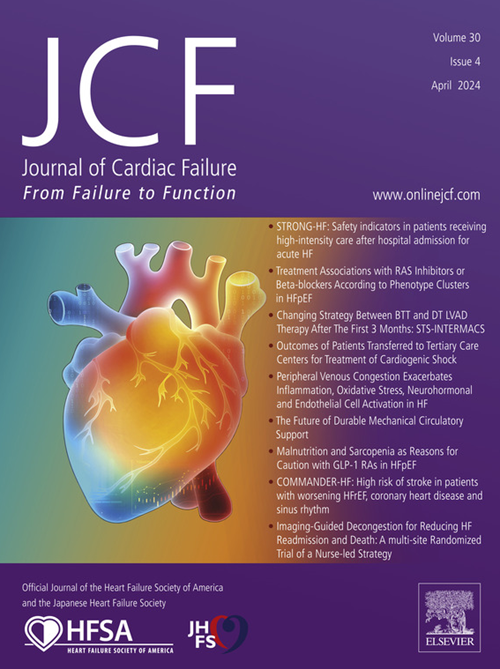增加急性心力衰竭患者的螺内酯用量会改变钾平衡,但不会增强去充血。
IF 6.7
2区 医学
Q1 CARDIAC & CARDIOVASCULAR SYSTEMS
引用次数: 0
摘要
背景:ATHENA-HF临床试验发现,在急性心力衰竭常规治疗的基础上加用螺内酯100毫克/天,持续96小时,利钠肽水平或临床充血状况均无改善:我们对ATHENA-HF进行了事后分析,以确定螺内酯治疗是否会引起任何可检测到的药效学效应,以及醛固酮活性可能更高的患者是否会出现额外的减轻充血现象。之前接受过螺内酯治疗的试验对象被排除在外。我们首先检查了肾脏钾处理的变化。我们将基线血清钾水平作为螺内酯活性的替代指标,然后将每个治疗组的基线血清钾分为三等分,并探讨实验室和临床充血结果的差异:结果:在未服用螺内酯的患者中,24 小时或 48 小时后血清钾的变化没有差异,但在 72 小时(0.23±0.55 vs 0.03±0.60 mEq/L,P=0.042)和 96 小时(0.32±0.51 vs 0.13±0.72 mEq/L,P=0.046),螺内酯治疗的血清钾变化明显大于安慰剂。虽然在治疗开始和 24 小时内补充钾的情况相似,但螺内酯治疗的患者在 48 小时(24% vs 36%;P=0.048)、72 小时(21% vs 37%;P=0.013)和 96 小时(11% vs 38%;PConclusions.P=0.013)时需要补充的钾大大减少:对于接受静脉襻利尿治疗的急性心力衰竭患者,螺内酯 100 毫克/天,持续 96 小时并无明显的减充血能力,但可有效限制钾消耗。本文章由计算机程序翻译,如有差异,请以英文原文为准。
Increased Spironolactone Dosing in Acute Heart Failure Alters Potassium Homeostasis but Does not Enhance Decongestion
Background
The ATHENA-HF (Aldosterone Targeted Neurohormonal Combined with Natriuresis Therapy in Heart Failure) clinical trial found no improvements in natriuretic peptide levels or clinical congestion when spironolactone 100 mg/day for 96 hours was used in addition to usual treatment for acute heart failure.
Methods
We performed a post hoc analysis of ATHENA-HF to determine whether spironolactone treatment induced any detectable pharmacodynamic effects and whether patients with potentially greater aldosterone activity experienced additional decongestion. Trial subjects previously treated with spironolactone were excluded. We first examined for changes in renal potassium handling. Using the baseline serum potassium level as a surrogate marker of spironolactone activity, we then divided each treatment arm into tertiles of baseline serum potassium and explored for differences in laboratory and clinical congestion outcomes.
Results
Among spironolactone-naïve patients, the change in serum potassium did not differ after 24 hours or 48 hours but was significantly greater with spironolactone treatment compared to placebo at 72 hours (0.23 ± 0.55 vs 0.03 ± 0.60 mEq/L; P = 0.042) and 96 hours (0.32 ± 0.51 vs 0.13 ± 0.72 mEq/L; P = 0.046). Potassium supplementation was similar at treatment start and at 24 hours, but spironolactone-treated patients required substantially less potassium replacement at 48 hours (24% vs 36%; P = 0.048), 72 hours (21% vs 37%; P = 0.013), and 96 hours (11% vs 38%; P < 0.001). When the treatment arms were divided into tertiles of baseline serum potassium, there were no differences in the 96-hour log N-terminal pro-B-type natriuretic peptide levels, net fluid loss, urine output, or dyspnea relief in any of the potassium groups, with no effect modification by treatment exposure.
Conclusions
Spironolactone 100 mg/day for 96 hours in patients receiving intravenous loop diuresis for acute heart failure has no clear added decongestive ability but does meaningfully limit potassium wasting.
求助全文
通过发布文献求助,成功后即可免费获取论文全文。
去求助
来源期刊

Journal of Cardiac Failure
医学-心血管系统
CiteScore
7.80
自引率
8.30%
发文量
653
审稿时长
21 days
期刊介绍:
Journal of Cardiac Failure publishes original, peer-reviewed communications of scientific excellence and review articles on clinical research, basic human studies, animal studies, and bench research with potential clinical applications to heart failure - pathogenesis, etiology, epidemiology, pathophysiological mechanisms, assessment, prevention, and treatment.
 求助内容:
求助内容: 应助结果提醒方式:
应助结果提醒方式:


